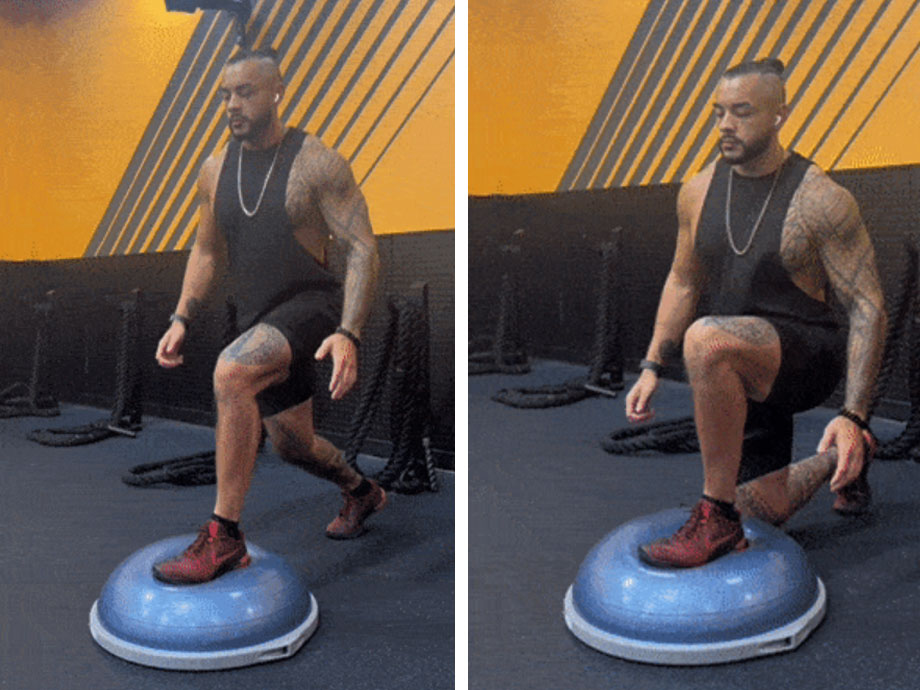We test and review fitness products based on an independent, multi-point methodology. If you use our links to purchase something, we may earn a commission. Read our disclosures.
The lunges exercise is already one killer of a lower-body exercise, targeting exercises like the glutes, quads, calves, and hammies. Throw in a BOSU Balance Trainer, commonly called a Bosu ball, and now you’re really cooking with gas!
The Bosu ball ups the ante in many ways: It increases lower-body and core muscle activation, adds an element of instability to improve balance and proprioception (your body’s ability to sense movement), and generally makes this bodyweight beast even more lethal.
Caine Wilkes, OLY, USAW-L1, and GGR senior staff writer, shares his step-by-step instructions on how to do Bosu ball lunges with the correct form. Then, we’ll cover exercise variations, alternatives, benefits, and more! Check it out below!
How To Do Bosu Ball Lunges
“The Bosu ball lunge is identical to your standard forward lunge in terms of the movement, but the stability ball will challenge your balance,” says Caine. “Move slowly to make sure you don’t topple, maintain a strong, upright posture with your upper body, and keep your core engaged.”
How to do it:
- Stand with a Bosu ball flat-side-down on the floor in front of you.
- Step forward onto the Bosu ball with your right foot.
- Slowly lean into your right knee, while lowering your left knee toward the ground.
- Continue until your front thigh is nearly parallel with the floor.
- Push yourself back up through your right foot and step back to the starting position.
- Repeat the movement, this time stepping forward with your left foot.
- Continue, alternating sides on each rep (or completing all reps on one side before switching to the other), until your set is complete.
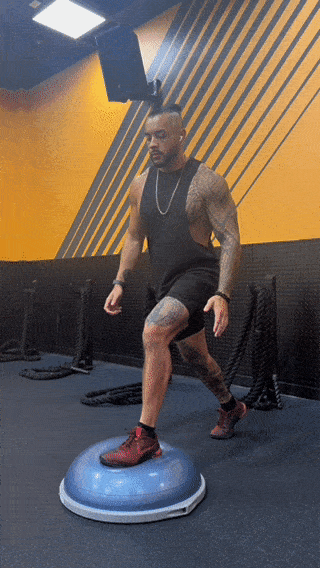
Modifications
- Dial it back: It takes time to get accustomed to the Bosu ball. You may consider doing regular bodyweight lunges at first to build lower-body strength and stability. Alternatively, you can start with Bosu ball squats since bilateral moves offer more stability than unilateral exercises.
- Make it harder: Perform your Bosu ball lunges holding a dumbbell or kettlebell for some added resistance, or try the Bosu ball curtsy lunge for a greater balance challenge.
How To Do Bosu Ball Lunges At Home
The beauty of bodyweight exercises is that they can be done anywhere, meaning lunges are one of the best exercises for your home workouts.
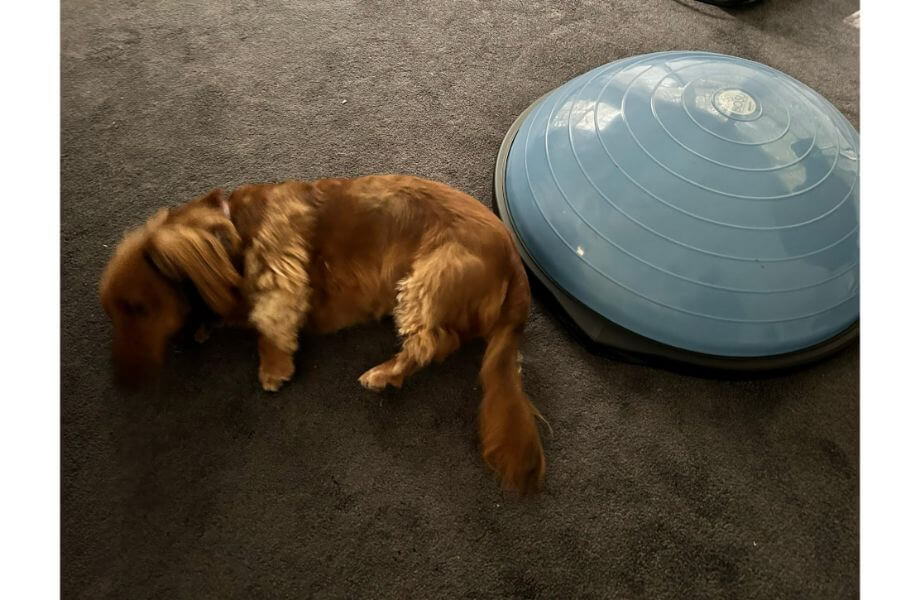
Of course, you’ll need a Bosu ball (or any of the best balance boards) to do balance training simultaneously. But, since they’re a versatile piece of bodybuilding home gym equipment, take up very little space, and are relatively inexpensive, they make a great addition to your collection.
Bosu Ball Lunges Variations
- Bosu ball side lunge: The Bosu ball side lunge uses side-to-side movement instead of standard forward-to-back movement, which shifts the emphasis to your gluteus medius, hip abductors, inner hamstrings, and vastus medialis.
- Bosu ball reverse lunge: Reverse lunges involve starting with both feet on the Bosu ball and stepping backward one leg at a time to enter your lunge stance, which targets the glutes and hamstrings with more intensity.
- Bosu ball curtsy lunge: If bodyweight curtsy lunges aren’t hard enough, this variation involves starting on the Bosu ball, stepping back as you would for a reverse lunge, and crossing your back leg behind your front leg to perform a pseudo-curtsy. You’ll need excellent balance to pull this one off!
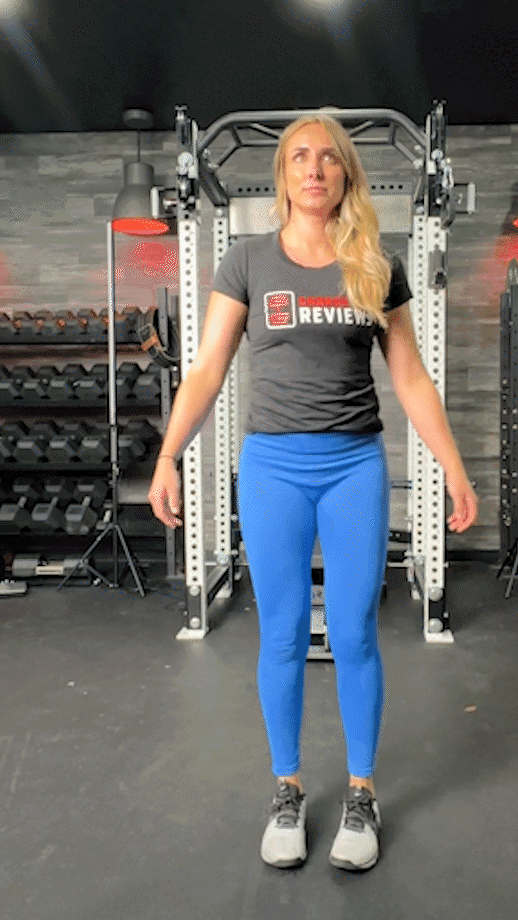
Bosu Ball Lunge Alternatives
From push-ups to planks, many Bosu ball exercises make this handy piece of fitness equipment worth the buy. Here are a few Bosu ball lunge alternatives to help you flesh out your lower-body workout and squeeze the most value out of your purchase!
Bosu Ball Squat
Why do it: Squats already reign supreme in terms of compound lower-body exercises, but doing them while standing on a Bosu ball offers a few added benefits. According to a 2017 study in the Journal of Strength and Conditioning Research1, instability training “[increases] ankle eversion and knee flexion with higher muscle activation in gastrocnemius, biceps femoris, and quadriceps,” which suggests improvements to ankle mobility, knee mobility, and lower body hypertrophy.
How to do it:
- Place a Bosu ball on the floor flat-side-up and step onto it.
- Stand up straight with your feet shoulder-width apart.
- Lower yourself into a squat by bringing your hips back and bending your knees.
- Continue until your thighs are nearly parallel with the floor.
- Pause, then push through your heels to stand back up.
- Repeat for reps.
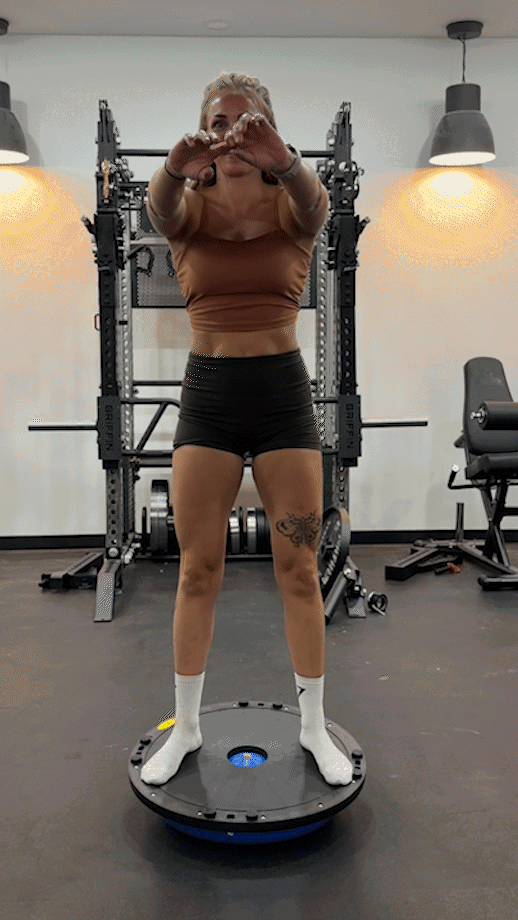
Bosu Ball Mountain Climber
Why do it: If you’re looking for a total-body workout with a touch of cardio, look no further than Bosu ball mountain climbers. This high-intensity exercise requires a strong upper-body and core in order to hold the position, powerful lower-body muscles to hammer out those reps, and stamina so you don’t gas out.
How to do it:
- Hold a Bosu ball to your chest and place it dome-side-down on the floor.
- Step your feet back and extend your elbows to enter the high plank position.
- Drive your right knee toward your right elbow.
- Bring your right foot back as you drive your left knee toward your left elbow.
- Continue alternating sides until you finish your desired number of reps.
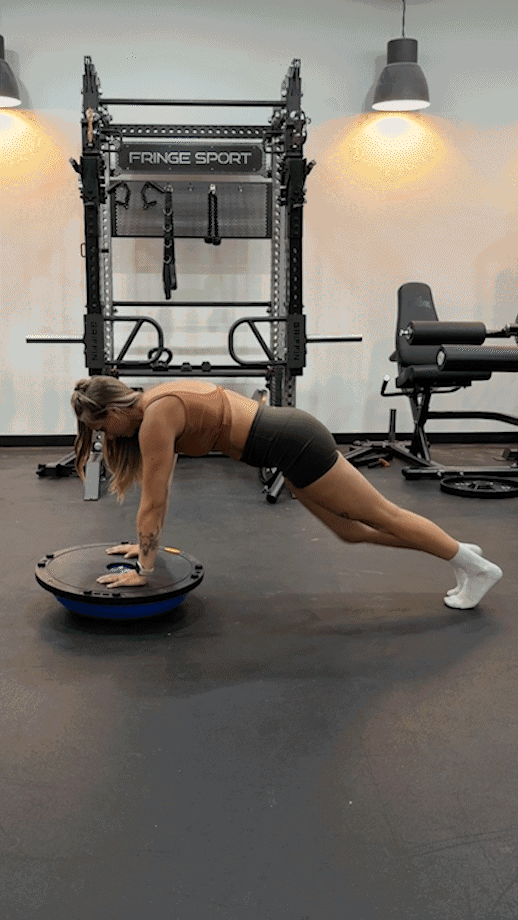
Bosu Ball Single-Leg Glute Bridge
Why do it: Okay, this one is a mouthful, but the—say it with me now—Bosu ball single-leg glute bridge is an absolute beast on your lower body and core. Focusing one leg at a time helps you build that all-important unilateral strength that’ll help you perform other unilateral exercises, like the lunge, with greater ease. That’s not all; according to Physical Therapy in Sport2, doing glute bridges on unstable surfaces increases EMG muscle activation in your core, making it a great ab workout.
How to do it:
- Lie supine (on your back) with your arms at your sides, palms pressed into the floor, knees bent, and your feet planted on the dome side of your Bosu ball.
- Raise your right leg in the air, pushing your left foot into the ball as you extend your hips.
- Squeeze your glutes at the top, then release and return to the starting position.
- Repeat for reps, then repeat the set with your left leg.
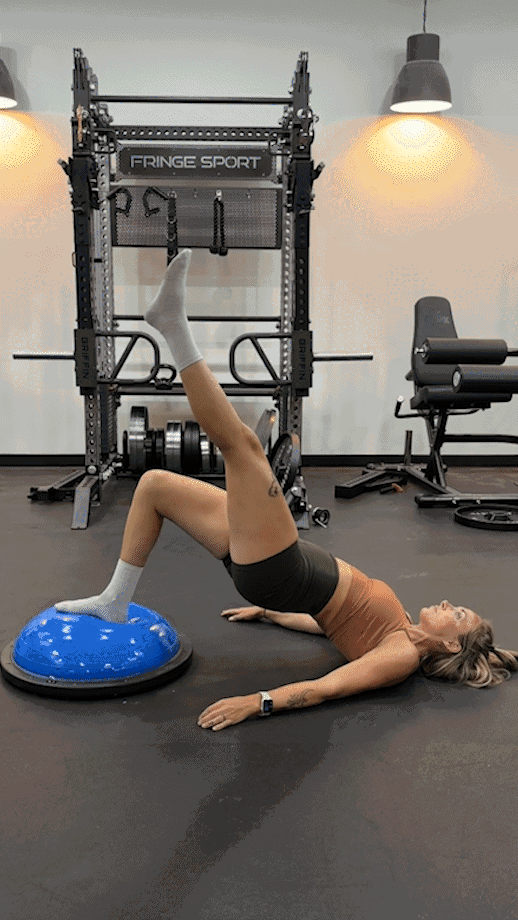
Bosu Ball Burpee
Why do it: Burpees—the exercise everybody loves to hate. Sure, they sap your stamina and tax muscle groups from head to toe, but that’s because it’s a full-body exercise that’ll work wonders for your strength and endurance. Now, throw in a Bosu ball, and this dreaded exercise just got tougher, adding a balance challenge at the bottom of each rep.
How to do it:
- Standing holding a Bosu ball with the flat side facing you.
- Bend forward and place the dome side of the Bosu ball on the floor.
- Jump or step your feet back to enter a push-up position.
- Lower your body to the floor, touching your chest to the ball and your thighs to the floor.
- Push yourself back into a high plank position.
- Jump or step your feet back to center, stand, and explode into a jump.
- Thrust the Bosu ball over your head mid-jump.
- Land softly, reset, and repeat for reps.
RELATED: 12 Best Burpee Alternatives
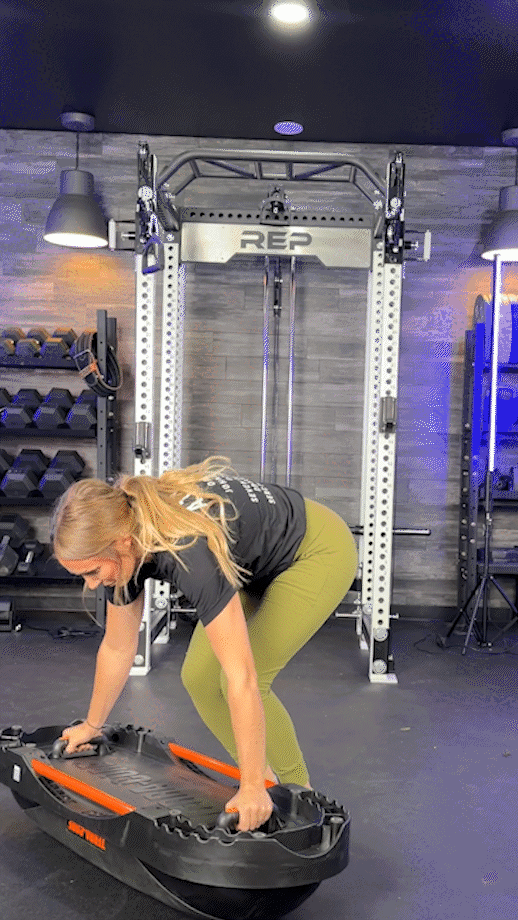
Benefits of Bosu Ball Lunges
Adding a Bosu ball to your lunges may seem scary, especially if you’re a beginner; however, there are many reasons you may want to consider adding them to your lower body workouts beyond your garden-variety gains.
Here are a few benefits specific to Bosu ball lunges that may convince you they’re worth your while.
May Enhance Unilateral Performance
Sprinting, cycling, jumping, and throwing are all examples of unilateral activities, meaning you’re working one side independently of the other. According to a 2022 study in the Journal of Sports Science & Medicine3, “unilateral conditioning activities,” like Bosu ball lunges, “can be effectively used to acutely improve a wide variety of athletic tasks.”
Athletes have a lot to gain if they plan to incorporate unilateral exercises into their training, but what about the rest of us?
Well, unilateral activities are found in everyday life, too. Carrying groceries, going up a flight of stairs, reaching forward to push or pull open a door—these are all unilateral activities many people will perform daily.
So, athlete or not, working unilateral exercises like the Bosu ball lunge may make your job—on the playing field and in everyday life—just a bit more manageable.
May Help Improve Balance
A 2016 study in the Journal of Athletic Training4 observed “improved dynamic postural control and ankle force production” of their subjects after a four-week balance training program that used a variety of Bosu ball exercises.
A 2022 study in Physical Activity and Nutrition5 mirrored these results, finding that the “lunge exercise on an unstable support surface was…found to improve dynamic balance” after an eight-week training program.
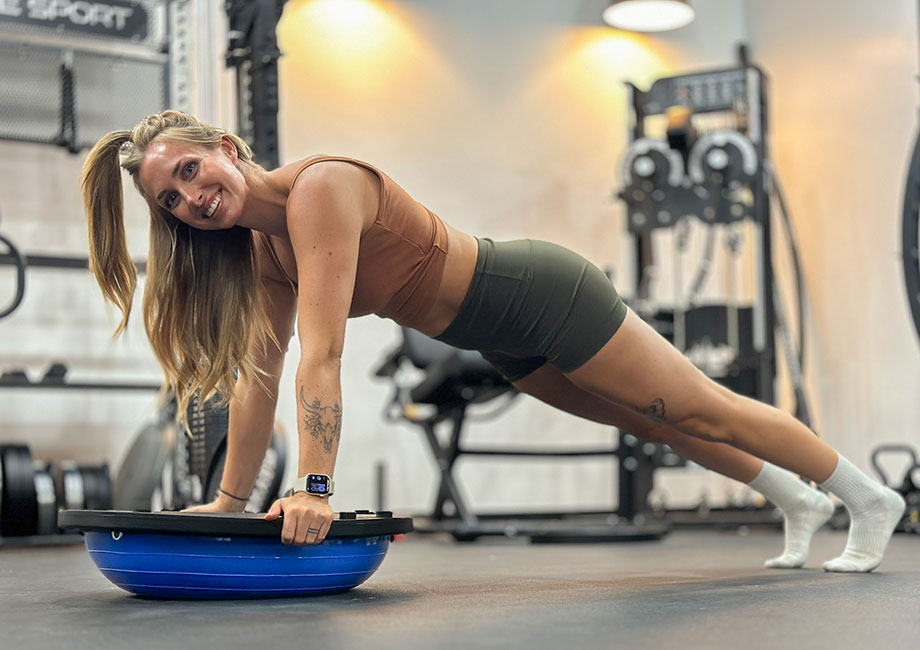
“Bosu balls impose an unstable surface on the user, meaning you’ll have to engage your core to a greater degree and make tiny adjustments for the duration of the exercise in order to prevent falling over,” says Caine Wilkes, OLY, USAW-L1. “That’s what makes Bosu ball exercises, like the Bosu ball lunge, so effective for improving your balance.”
RELATED: Best Balance Exercises
May Reduce Risk of Injury
Better balance means you’re less likely to take a spill, but that’s not the only way Bosu ball exercises may help reduce your risk of injury. According to Sports Health6, using “unstable surfaces,” like Bosu balls, “as a training tool [may] reduce the risk of ACL injury,” too.
That’s because Bosu ball exercises are low impact, meaning they put minimal stress on your joints. Minimizing joint stress contributes to joint longevity, meaning you should have a greater quality of life for longer. It’s especially important for elite athletes, older adults, and individuals training around past injuries.
Common Bosu Ball Lunge Mistakes
It’s important to perform your Bosu ball lunges with proper form if you’re going to get the most benefit from the exercise. If you can avoid the following mistakes while learning the movement, you’ll be a pro in no time!
Incorrect Stride Length
Getting the right stride length isn’t totally specific to Bosu ball lunges; your regular lunges benefit from perfecting your lunge form, too. That’s because going too wide may place undue stress on your knee joint, especially if your front knee extends past your toes. Going too narrow reduces your range of motion (ROM), making the exercise less impactful.
“Ideally, your lunge should be wider than your walking stride,” adds Caine. “You want your front knee bent at a 90-degree angle and your back knee bent, but it should not touch the floor in the end position. Instead, it should hover roughly two to four inches off the floor.”
RELATED: Walking Lunges
Poor Core Engagement
Just because the Bosu ball lunge wreaks havoc on the lower body doesn’t mean we can ignore what our upper body is up to. Proper form requires a neutral neck and spine, so you’ll want your back straight, chest tall, shoulders down and back, and eyes facing forward at all times.
“If you find yourself arching or rounding your back, it may indicate that you’re not bracing your core properly,” says Caine. “Inhale through your nose, imagine pulling your belly button to your spine, then exhale and brace like someone’s about to punch you in the stomach.”
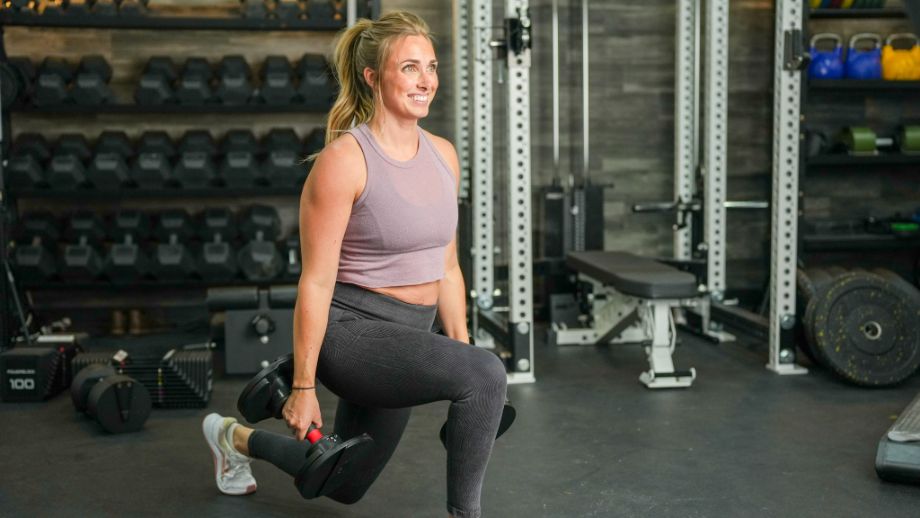
RELATED: Beginner Core Workout
Learning how to brace your core takes practice, so don’t be afraid to recruit the services of a certified personal trainer or other qualified fitness professional if you’re having trouble. It’s tricky, but it’s crucial for protecting yourself from a slew of nasty injuries associated with poor form during exercise.
Not Squaring Your Hips
“As you step forward into your lunge, you want your hips to open up and face the wall in front of you,” says Caine, “but hip tightness and mobility issues may make this difficult or impossible.”
Your hips don’t lie. Not squaring your hips during the lunge exercise, whether you’re using a Bosu ball or not, may put undue stress on your joints and contribute to pains, strains, or injuries. So, take your time with each rep, focus on opening your hips in the end position, and, if you’re having difficulty, try some of the best mobility exercises to get your hips ready for action before your workout.
Muscles Worked by Bosu Ball Lunges
The Bosu ball lunge is heavy on the lower-body muscles, but that’s not the only region where you’ll see muscle activation. These are the various muscles worked by Bosu ball lunges:
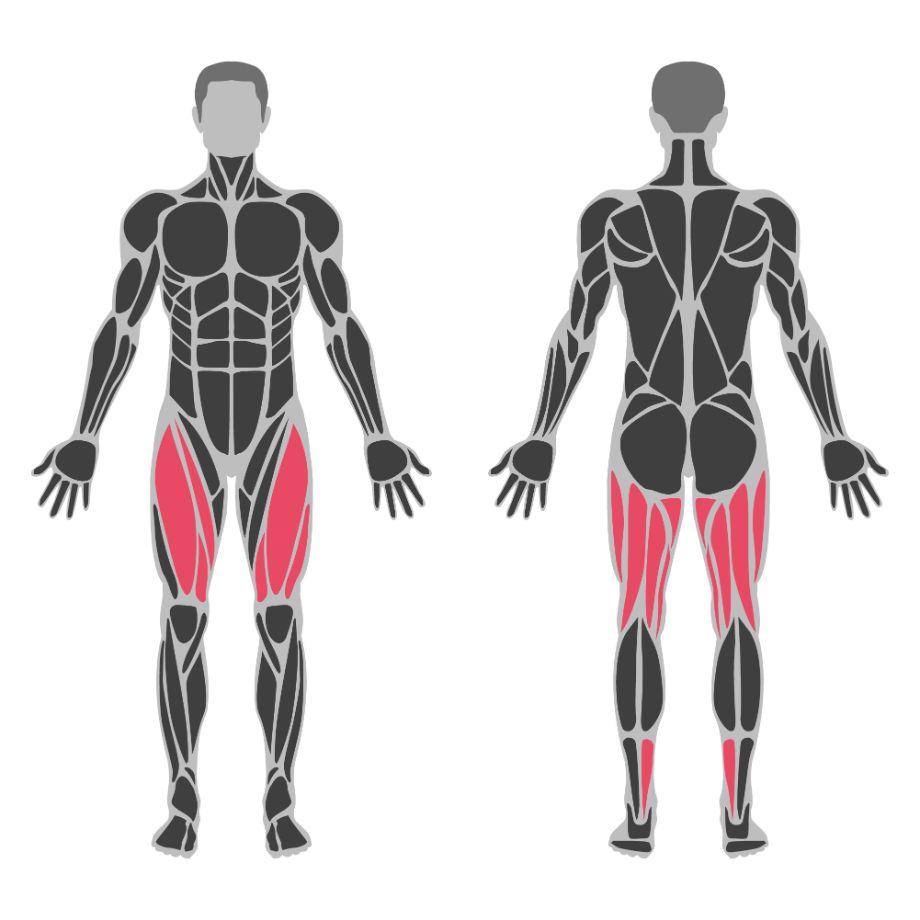
- Quadriceps: Your quads are the prime mover for the Bosu ball forward lunge, as they’re crucial for maintaining a solid end position and producing enough power to get your front foot back to center after each rep.
- Glutes: Your glute muscles are also integral to good biomechanics. They’re responsible for opening your hips in the end position and ensuring each muscle group gets properly activated, minimizing your risk of injury while maximizing your ability to produce power.
- Hamstrings: Located on the back of your thighs, your hammies help you get into your lunge by assisting with knee flexion and controlling your descent. They also contract as you step back toward the center.
- Core: Any standing exercise involving maintaining an upright posture will recruit your core muscles to accomplish that critical positioning, but using a Bosu ball makes it more difficult to hold yourself steady. So, you’ll get even more core activation.
RELATED: What Muscles Do Lunges Work?
Bosu Ball Lunges: Final Thoughts
We’d never disparage your everyday barbell-based strength training or machine-based cardio workout programs, but isn’t it time to literally shake things up by working Bosu ball exercises into the mix?
As a fundamental movement pattern, lunges are already a fantastic exercise. Bosu ball exercises are also highly effective for improving balance and mobility. Combine these two elements, and you have the formula for fitness success.
In summary, our exercise experts highly recommend Bosu ball lunges because:
- They provide a load of lower-body muscle activation
- They may enhance unilateral performance
- They may improve overall balance
- They may reduce your risk of injury
- They recruit your core muscles more than regular bodyweight exercises
Are you ready to see what benefits training with a Bosu ball may bring? Add Bosu ball lunges into your lower-body workout and lunge your way to greater gains!
Bosu Ball Lunges: FAQs
Are bosu ball workouts effective?
Bosu balls can be highly effective because they take tried-and-true bodyweight exercises and add an element of instability to demand greater muscle recruitment from the target muscles. They’re incredible for building balance while helping increase your muscle size, strength, and stamina.
What muscles does the bosu ball work?
The Bosu ball lunge predominantly targets your lower-body muscles. But you’ll still enjoy some upper-body activation, too, since you’ll need to hold a steady position throughout the range of motion.
Since you can perform most bodyweight exercises with a Bosu ball, you can get a full-body workout using just a Bosu ball, making it an incredibly versatile piece of equipment and an intuitive addition to your home gym setup.
Are lunges good or bad for you?
“Lunges have gotten a bad rap over the years for causing various injuries, but, as long as you’re performing them correctly, they’re actually quite good for you,” says Caine Wilkes, OLY, USAW-L1, and GGR senior staff writer. “They work the lower body, help improve balance, and burn calories, which may contribute to weight loss. Lunges are actually among the best exercises, in my opinion.”
If you’re new to lunges, the good news is they’re pretty beginner-friendly. That said, don’t be shy about hiring a personal trainer or other qualified fitness professional to make sure you’re doing them with the proper form.
RELATED: Best Online Personal Trainers
References
- Nairn BC, Sutherland CA, Drake JD. Motion and Muscle Activity Are Affected by Instability Location During a Squat Exercise. J Strength Cond Res. 2017;31(3):677-685. doi:10.1519/JSC.0000000000001745
- Czaprowski D, Afeltowicz A, Gębicka A, et al. Abdominal muscle EMG-activity during bridge exercises on stable and unstable surfaces. Phys Ther Sport. 2014;15(3):162-168. doi:10.1016/j.ptsp.2013.09.003
- Krzysztofik M, Wilk M, Pisz A, et al. Effects of Unilateral Conditioning Activity on Acute Performance Enhancement: A Systematic Review. J Sports Sci Med. 2022;21(4):625-639. Published 2022 Dec 1. doi:10.52082/jssm.2022.625
- Cuğ M, Duncan A, Wikstrom E. Comparative Effects of Different Balance-Training-Progression Styles on Postural Control and Ankle Force Production: A Randomized Controlled Trial. J Athl Train. 2016;51(2):101-110. doi:10.4085/1062-6050-51.2.08
- Lee J, Kim J. Effects of an 8-week lunge exercise on an unstable support surface on lower-extremity muscle function and balance in middle-aged women. Phys Act Nutr. 2022;26(4):14-21. doi:10.20463/pan.2022.0020
- Shultz R, Silder A, Malone M, Braun HJ, Dragoo JL. Unstable Surface Improves Quadriceps:Hamstring Co-contraction for Anterior Cruciate Ligament Injury Prevention Strategies. Sports Health. 2015;7(2):166-171. doi:10.1177/1941738114565088
Further reading

A certified strength coach breaks down the benefits, best alternatives, the do’s and don’ts, and everything in between of the old-school Jefferson squat. Read more

Our experts tested dozens of premium sneakers before hand-selecting this list of the top 9 best running shoes for women. Read more

Looking for the answer to “How often should you work out?” A CPT explains how much the average adult should exercise, and describes the benefits of working out. Read more

A commonly asked question is, "Can I mix creatine with pre-workout?" With this guide, discover the best way to utilize both supplements to build muscle, recover quickly, and achieve your fitness goals. Read more

